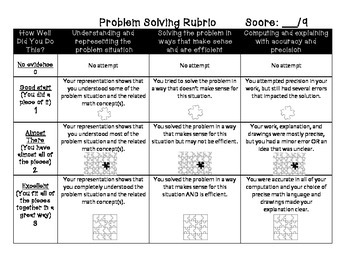Math Lady in MD
1.1k Followers
Grade Levels
1st - 6th
Subjects
Resource Type
Standards
CCSS1.OA.A.1
CCSS2.OA.A.1
CCSS3.OA.A.3
CCSS4.OA.A.3
CCSS5.NF.A.2
Formats Included
- PDF
Pages
1 page
Math Lady in MD
1.1k Followers
Description
Do you ever struggle to give students meaningful feedback about their problem solving? When you score a student's problem solving, are you able to find a next teaching point? By using this rubric, you will not only be able to provide feedback but also choose teaching points appropriate for each student!
Please try it out FREE and leave feedback!
TPT MDMathLady
Please try it out FREE and leave feedback!
TPT MDMathLady
Total Pages
1 page
Answer Key
Does not apply
Teaching Duration
N/A
Report this resource to TPT
Reported resources will be reviewed by our team. Report this resource to let us know if this resource violates TPT’s content guidelines.
Standards
to see state-specific standards (only available in the US).
CCSS1.OA.A.1
Use addition and subtraction within 20 to solve word problems involving situations of adding to, taking from, putting together, taking apart, and comparing, with unknowns in all positions, e.g., by using objects, drawings, and equations with a symbol for the unknown number to represent the problem.
CCSS2.OA.A.1
Use addition and subtraction within 100 to solve one- and two-step word problems involving situations of adding to, taking from, putting together, taking apart, and comparing, with unknowns in all positions, e.g., by using drawings and equations with a symbol for the unknown number to represent the problem.
CCSS3.OA.A.3
Use multiplication and division within 100 to solve word problems in situations involving equal groups, arrays, and measurement quantities, e.g., by using drawings and equations with a symbol for the unknown number to represent the problem.
CCSS4.OA.A.3
Solve multistep word problems posed with whole numbers and having whole-number answers using the four operations, including problems in which remainders must be interpreted. Represent these problems using equations with a letter standing for the unknown quantity. Assess the reasonableness of answers using mental computation and estimation strategies including rounding.
CCSS5.NF.A.2
Solve word problems involving addition and subtraction of fractions referring to the same whole, including cases of unlike denominators, e.g., by using visual fraction models or equations to represent the problem. Use benchmark fractions and number sense of fractions to estimate mentally and assess the reasonableness of answers. For example, recognize an incorrect result 2/5 + 1/2 = 3/7, by observing that 3/7 < 1/2.


